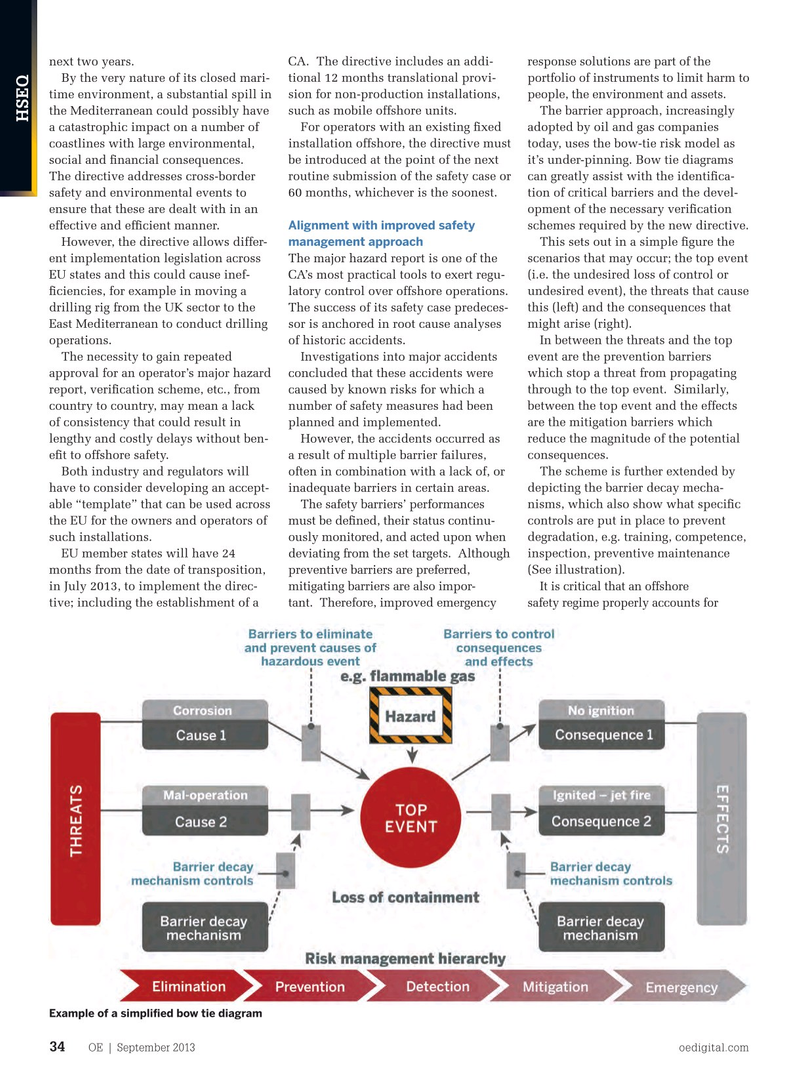
Page 32: of Offshore Engineer Magazine (Sep/Oct 2013)
Read this page in Pdf, Flash or Html5 edition of Sep/Oct 2013 Offshore Engineer Magazine
next two years. CA. The directive includes an addi- response solutions are part of the
By the very nature of its closed mari- tional 12 months translational provi- portfolio of instruments to limit harm to time environment, a substantial spill in sion for non-production installations, people, the environment and assets.
the Mediterranean could possibly have such as mobile offshore units. The barrier approach, increasingly
HSEQ a catastrophic impact on a number of For operators with an existing fxed adopted by oil and gas companies coastlines with large environmental, installation offshore, the directive must today, uses the bow-tie risk model as social and fnancial consequences. be introduced at the point of the next it’s under-pinning. Bow tie diagrams
The directive addresses cross-border routine submission of the safety case or can greatly assist with the identifca- safety and environmental events to 60 months, whichever is the soonest. tion of critical barriers and the devel- ensure that these are dealt with in an opment of the necessary verifcation effective and effcient manner. schemes required by the new directive.
Alignment with improved safety
However, the directive allows differ- This sets out in a simple fgure the management approach ent implementation legislation across The major hazard report is one of the scenarios that may occur; the top event
EU states and this could cause inef- CA’s most practical tools to exert regu- (i.e. the undesired loss of control or fciencies, for example in moving a latory control over offshore operations. undesired event), the threats that cause drilling rig from the UK sector to the The success of its safety case predeces- this (left) and the consequences that
East Mediterranean to conduct drilling sor is anchored in root cause analyses might arise (right). operations. of historic accidents. In between the threats and the top
The necessity to gain repeated Investigations into major accidents event are the prevention barriers approval for an operator’s major hazard concluded that these accidents were which stop a threat from propagating report, verifcation scheme, etc., from caused by known risks for which a through to the top event. Similarly, country to country, may mean a lack number of safety measures had been between the top event and the effects of consistency that could result in planned and implemented. are the mitigation barriers which lengthy and costly delays without ben- However, the accidents occurred as reduce the magnitude of the potential eft to offshore safety. a result of multiple barrier failures, consequences.
Both industry and regulators will often in combination with a lack of, or The scheme is further extended by have to consider developing an accept- inadequate barriers in certain areas. depicting the barrier decay mecha- able “template” that can be used across The safety barriers’ performances nisms, which also show what specifc the EU for the owners and operators of must be defned, their status continu- controls are put in place to prevent such installations. ously monitored, and acted upon when degradation, e.g. training, competence,
EU member states will have 24 deviating from the set targets. Although inspection, preventive maintenance months from the date of transposition, preventive barriers are preferred, (See illustration). in July 2013, to implement the direc- mitigating barriers are also impor-
It is critical that an offshore tive; including the establishment of a tant. Therefore, improved emergency safety regime properly accounts for
Example of a simplifed bow tie diagram
OE | September 2013 oedigital.com 34 032_OE0913_HSEQ1_DNV.indd 34 8/18/13 11:05 PM

 31
31

 33
33